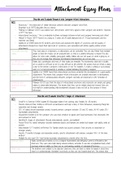Attachment Essay Plans
Describe and Evaluate Research into Caregiver-infant Interactions
AO1:
- Reciprocity ~ the interaction of similar behaviour patterns between caregiver and infant
- Brazelton et al (1975) describes this as a dance.
- Feldman & Eidleman (2007) says babies have ‘alert phases’ where they signal to their caregiver and mothers’ response
2/3rds of the time.
- Interactional Synchrony ~ the co-ordinated rhythmic exchanges between infant and caregiver (mirroring each other)
- Meltzof & Moore (1977) found it as young as 2 weeks old. An adult displayed one of 3 facial expressions and the
response was filmed.
- Isabella et al. (1989) observed 30 mothers and infants and assessed the degree of synchrony and the quality of
attachment. Researchers found that high levels of synchrony were associated with better quality mother-infant
attachment.
The studies have high They took place in a laboratory, so distractions can be controlled. They are also filmed from multiple
validity angles so that the results can be analysed later, so that it is unlikely behaviour is missed. This also
allows for inter-rater reliability giving good validity. Babies also are not aware of what is going on, so
they do not change their behaviour and demand characteristics are not an issue.
It is difficult to observe Babies lack coordination and most of their bodies are immobile. The movements observed in studies
infant behaviour are so small it is difficult to see. It is also difficult to tell whether the actions that an infant is doing
is due to the primary caregivers’ interactions or not. For example, if a baby is smiling or just passing
wind, or if a hand movement is random or instead imitating the primary caregiver.
Synchrony predicts Isabella et al. (1989) found that interactional synchrony predicted the development of a good quality
quality of attachments attachment. This means that caregiver-infant interactions are probably important in development,
and the level of communications between caregiver and baby are important in the formation of
attachments.
Synchrony and Feldman (2012) says that the ideas of interactional synchrony and reciprocity are simply just giving
reciprocity are just names to observable behaviours. This means that they can be reliably observed, however they are
names not helpful in understanding child development because it does not tell us the purpose of these
behaviours.
Describe and Evaluate Schaffer’s Stages of Attachment
AO1:
- Schaffer & Emerson (1964) studied 60 Glaswegian babies from working class families for 18 months.
- Parents observed their children in different circumstances and keep a diary of their behaviours, measuring things like
separation and stranger anxiety.
- 50% of babies showed separation anxiety towards primary caregiver between 25 and 32 weeks. At 40 weeks 30%
had multiple attachments.
- Attachment tended to be the caregiver who was most sensitive to signals and facial expressions (not necessarily the
most amount of time)
- Identified 4 stages of attachment (Asocial, indiscriminate, specific, and multiple)
- Asocial (first few weeks) behaviour towards inanimate objects and humans are similar but happier with adults, smile at
anyone
- Indiscriminate (2-7 months) preference for familiar people, but accept company from anyone, no separation or
stranger anxiety
- Specific (7 months) stranger and separation anxiety, specific attachment with primary caregiver (65% of the time
mother)
- Multiple (by one year) 29% had formed secondary attachments a month after the first.
External validity Study carried out in homes, so it is a natural environment and behaviour weren’t affected by the
observers. They were also made during natural ordinary activities. It was also a longitudinal study which
increases internal validity as there are no confounding variables of individual differences.
Mother bias The mothers were unlikely to be objective observers, they are likely to either be biased in what they
report, or unintentionally remember incorrectly as they are not trained observers. This means that
, even if babies displayed natural behaviour, it may not have been recorded correctly meaning that
there could be validity issues with the data.
There are difficulties Young babies have poor coordination and are fairly immobile, this makes it difficult to make judgements
studying infants about their behaviour, they may be social but appear unsocial due to flawed methods, and not looking
for the correct behaviours. Also assessing separation anxiety can be difficult; just because a baby gets
distressed when someone leaves the room does not mean that they have an attachment. The stages
of attachments do not distinguish between behaviour to attachments and playmates.
Real-world applications The effects of these stages can be seen in everyday life. In the asocial and indiscriminate stages
childcare is likely to be straightforward as babies can be comforted by any adult. However, a baby
starting nursery in the specific attachment stage with an unfamiliar adult may be problematic as they
experience both separation and stranger anxiety.
Discuss What Research Has Shown about the Role of the Father in Attachment
AO1:
- Grossman et al. (2002) carried out a longitudinal study where babies were studied into their teens. The researchers
looked at both parents’ behaviour and its relationship to the quality of their babies’ later attachments. This suggested
that attachment to fathers is less important than mothers.
- They also found that the fathers’ quality of play with babies was related to the quality of adolescent attachments.
This suggests that fathers have a different role which is to do with play and stimulation and less to do with emotional
development.
- Field (1978) filmed 4-month-old babies’ interactions with primary caregiver mothers, secondary caregiver fathers and
primary caregiver fathers. Primary caregiver mothers spent more time smiling, imitating and holding babies than the
secondary caregiver fathers.
- Fathers have the potential to be the more emotion-focused caregiver and can provide the responsiveness required for
a close emotional attachment but perhaps only when they are in the primary caregiver role.
Inconsistent findings Grossman (2002) found fathers had an important role in play and stimulation, and Hrdy (1999) found
that fathers were less able to detect low levels of infant distress, in comparison to mothers. However,
fathers can take on the role of primary caregiver so there is not a simple answer into what the
specific role of the father is.
McCallum & Golombok (2004) found that parents growing up in single or same-sex parent families
don’t develop differently, therefore this suggests that the father’s role as a secondary attachment
figure is not important.
Unclear why fathers Research does not conclude why fathers have the role they do. It could be due to traditional social
play the role they do gender roles, where women are expecting to be more caring and nurturing than men so men don’t feel
they should act in a nurturing way. Or there could be biological factors involved. It could be that
female hormones or brain structure creates higher levels of nurturing and therefore women are
biologically predisposed to be primary attachment figures.
Real-Life applications This research can be used to offer advice to parents. A lot of mothers feel pressured to stay at home
with their children because of research stating mothers are crucial for healthy emotional development.
However, knowing that fathers are capable of taking the primary caregiver role can be reassuring. In
some families it could be a better decision economically for the father to stay at home and the
mother go to work, and this research may comfort mothers making these decisions.
Social Bias Social bias may prevent objective observation. Social stereotypes such as fathers being more playful
and stricter, may cause unintentional observer bias where observers see what they expect to see
rather than recording the reality of the situation.
Describe and Evaluate Animal Studies of Attachment
AO1:
- Lorenz (1952) investigated imprinting in geese. He raised 6 eggs in a natural environment and 6 raised in an incubator
where the first moving object they saw was Lorenz. The geese were then put together and observed who they
followed. The incubator group followed Lorenz and the control group followed the mother.
- Lorenz found there was a critical period where if imprinting did not occur it never would. Sexual imprinting also occurs
where a template was acquired of the desirable characteristics required ion a mate.





